#difference between get and post in java
Explore tagged Tumblr posts
Text
I was browsing UnixPorn on Reddit and was reminded how opinionated people get about Linux. Sure I have my opinions, but I by no means believe my opinions extend outside personal preference.
I feel like it's a tell-tale sign between Linux as a hobby, and Linux as a tool. Hating SystemD is great and all, I personally prefer OpenRC, but if I actually need to use the system I'm going to want the init system that has the best online support.
There is no singular "right" way to use Linux. I fully understand both wanting to use Linux for its benefits as an operating system as well as using Linux because it's fun to customize. I do both. But I think people, specifically those who like more fringe systems, can tend to forget that some people just want an out of the box Linux experience that will work for as long as they need it to.
This mentality is by no means unique to Linux, I see it in many tech spaces. Yes Rust is objectively better designed than Java, but Java is easier to learn and hire for. I feel like many newcomers to these things can get pressured into making their life harder than it needs to be to meet other people's standards.
I suppose the moral of this post is; remember everyone has different needs, and your opinions do not trump those needs.
I always somehow manage to turn my commentary on the Linux community philosophical. Humanity reveals itself to be consistent in many strange ways.
131 notes
·
View notes
Text
(remaking the post because you can't edit polls and i gave the wrong options)
Alright I'm registering for classes and someone needs to talk me out of doing stupid shit but I'm unsure of what shit is stupidest.
Winter term:
I just finished an 8-week photo class that ended up being a huge investment in time just to go and shoot. However that was introductory photography and there is a 6-week intermediate photography class over winter term. I am signed up for photography. (Elective option for AA in Visual Arts)
There is also a 6-week introductory python course over winter term that I am signed up for and will be taking. I'm solid on that one, as long as I pass my C# class this term I'm going to be taking Python for 6 weeks at the beginning of the year.
Spring term:
College Chemistry Saturday class. 7am to 12pm for sixteen weeks. Lab and lecture; this school doesn't offer any chem classes that are after standard 9-5 hours during the regular week or that can be taken even partially online. Pretty sure I'm going to be stuck with this one and am configuring the rest of my schedule around being *less* miserable because of this class.
Survey of Western Art - Online, seems like a gimme. Does have a textbook but not one that I'm going to pay for. (Required for AA in Visual Arts)
2-Dimensional Design - Online, seems fun and like a gimme, Free/No textbook. (Required for AA in Visual Arts)
Object-Oriented Programming - Online, seems difficult, expensive textbook. Will probably be very necessary if I end up going down a more CS/tech path. Probably going to force myself to take this class.
Java Programming - Online, seems not unapproachable, expensive textbook. I don't particularly wanna but my school offers really limited options for computer science and I want to get what I can out of it before I go somewhere else.
Rationale for these weird combinations:
I'm applying as a nursing student at three schools and a biochem student at one of those schools (nutrition programs are apparently only for first-time students; 2nd Bachelor's applications are a lot more limited. I could apply to major in Francophone Studies at one of the schools though). Supposing I get accepted, these classes certainly won't hurt my status at any school that accepts me and the chemistry class is going to be really really necessary. This is the "i give a fuck about nutrition science and also directly helping people" path and if I go this way I'm interested in NP programs down the line. LOTS more school of the serious "I can't work and do this kind of school at the same time" variety.
If I *don't* get accepted to the programs I'm applying to, I'm going to go to a different community college and start working on a couple of AS degrees in computer junk (network admin and security management, computer and networking technology) and get some computer junk certs. I don't think I want/need a BS in compute science, this is the "practical" route of "I could finish this stuff pretty easily and continue working in a field where I have a lot of connections and familiarity with the industry but I am indifferent about a lot of it (pretty passionate about security and accessibility tho). Also allows me to keep working while I just churn school in the background, and all of the computer classes are transferable between the two schools.
Art classes: I think having multiple degrees is funney. I am currently 5 classes away from an AA in visual arts, at the end of this term I will be 4 classes away; if I take all the classes here and can take an elective over the summer I'll have a degree in visual arts. (There is a reasonable possibility that I'll continue taking bullshit classes behind the scenes to get silly degrees regardless of what happens otherwise)
Pretty sure the sensible thing is to drop *at least* photography and survey of western art and also possibly Java and 2D design. I'm somewhat concerned that if my spring term is just Saturday chem and object oriented programming I will start biting things.
So:
86 notes
·
View notes
Text
nothing's wrong-- i'm just a STEM student...



[i rarely see stem rep-- so here’s PART TWO! (find part one here) the extended edition of ‘stoners in stem’ highlighting the parts of this life that i find myself loving ;p
Thinking of doing sectionals (Physics, Environmental Studies, Mechanics, Entomology, etc.), so if there are any suggestions you'd like to highlight, plz tag or comment !!]
TAG YOURSELF !! I LOVE SEEING WHAT YALL GET UP TO !!
slightly concerned glances being shared between even the worst of acquaintances when your mentor drops some crazy lore surrounding how they entered their field(s)
good god. the apple-cider vinegar and dish soap gnat traps. honey alternatives decidedly never cross anyone's mind (nor the threshold of the lab for that matter)
walking the fine line between the Ridiculous and the Logical during data analysis like the two aren't twin kings of ruin
either strong answers or noncommital shrugs when asked anything about your preferred diet or eating habits
writing exclusively with pen, or exclusively with pencil. feeling borderline disgusted having to use the other in the lab or when you forget your own
'Why do you care?' 'Why don't you??'
Every documentary you watch absolutely changing your life and challenging your worldview
Either hanging onto your textbooks like a lifeline or forgetting about them as they gather dust under your bed. maybe you never bought them at all-- pirated PDFs littering your desktop
anything in jars being considered decor (snakes, regurgitated bones, praying mantis egg cases)
seeing the slant of fences, trees, and lamp posts-- thinking of all the wind and weather that's passed along the same path you have
TREEHUGGER !!! HA HA
the clean quiet that hangs over the linoleum early in the morning; the warmth is not so subtle now that you've rolled up your sleeves.
teaching everyone around you how to bypass PAY FOR ARTICLES because knowledge should always be F[ree]INED [inspect, gear, disable java]
having to just sit by n watch while someone pointedly ignores your input, and a totally avoidable incident (that could have totally been avoided) is not, in fact, avoided
dealing with the consequences of that incident for the rest of the experiment/project
blank stare, lips in a placatingly firm line as you nod along with the stern talking-to you're being given. their words going in one ear and out the other because you're already thinking through another way under admin's nose ('no, I absolutely get you, 100%. it won't happen again.' [sometime later in the halls] 'yeah, no--- fuck that dude, I'm thinking this time we just gotta hit em harder with smth else...')
whaaaaat ? how'd those local Indigenous species just pop up everywhere overnight, ha ha ? wow nature is crazyyy
digging through public records for one reason, only to uncover an entirely different can of worms about the institution you frequent
digging in the literal dirt and uncovering literal worms lol amirite guys
'Please remember that this is just a prototype and that i'm it's in a very fragile state right now.'
going crazy trying to figure out what a specific testing company uses in their chemical compounds, because good fucking god how are you supposed to cite the evidence if you can't even label what it is?
a disastrous experiment being abandoned like Chernobyl once determined beyond salvation-- everyone curious to see how it'll develop and fester when left on its own
'life imitates art,' you think, as you finally recognize one of your unnecessarily complicated formulas being unexpectedly represented in your daily life
often being so bad at the thing you love that you can't do anything about it but laugh
staring for so long at something during a lecture that white begins to leech into your vision. you should probably blink a few times so people don't begin to suspect you're a reptile (even more than they already do)
'Don't.. don't look at me like that...' [speaking to a(n) (INSERT NAME OF LITTLE CRITTER HERE) you had to gently move onto a little scale to collect data]
honing in on where your talents in your field lie; the disappointment in finding your limits that turns to indifference when you remember you're still phenomenal at a million other things you enjoy
'i want to study you like a bug....'
thinly concealed irritation masked by a patient smile and a small 'mhm' when someone tries to explain your life's purpose TO you (ten dollars says they're wrong about it, too)
'and you want me to run this... on a full moon?' 'don't start with that shit again.'
yer disgust is lookin' a lot like morbid curiosity these days...
a lot of your scientific conclusions being discerned by common sense ('Please just use your cognitive functions, you guys...')
a clean earth sciences lab floor.. my white whale...
the small (increasingly large) pile of recyclable material that's waiting to be torn apart or filled with soil and plants; it topples over when people walk past, but no one can bring themselves to throw any away
'all this only cost me like... $270. which is crazy given that these're the real-fuckin'-deal solid-steel reinforcements.' 'man...this shit is so gonna blow down.'
leaning into the obscure, instead of away from it out of habit; seeing its effect in your daily life and work
all the plastic utensils in the dining area being stolen for diagrams, leaving behind only the reusable metalware. this is unexpectedly admirable of the engineers, if only to those who care about the inadvertent environmentalism
taking things apart to see how they work-- having very little planned on how to put them back together
'I don't know what you want me to do about that, you created it.' 'Not on purpose!'
downloading photomath during testing season. your doubt being palpable over your (in)ability to solve simple equations
carrying hand lotion everywhere you go because of how often your work has you washing your hands; colleagues and peers holding their hands out like beggars in a Mel Brooks film ('lotion... dollop of lotion for the poor D:')
borrowing chemical-grade goggles from the lab before going out to protest; supervisors giving you dubious thumbs ups while they 'accidentally' leave the key to the goggle sanitation station right by the cabinet..
'Now that you've poured your blood, sweat, tears, and other secretions into this project-- decide if you want to take it home to maintain, or have it eradicated.'
utilizing the public library, but having to double-check the internet before citing anything from the books you pour over because your city is more concerned with the way the building looks than the content it supplies
'The Martian,' both the book and the movie ... Mark Watney you will always be famous,,
'Why are you taking so many difficult classes at once?' 'My entire degree is difficult classes.'
carrying a small journal everywhere in an attempt to organize your thoughts, tasks, and reminders (you've never looked back on a single thing you've written, but you like to think it at least helps in the moment)
being torn between the scientific evidence that supports getting eight hours of sleep and your own hubris. you can stay up it's fine. it'll be fine.
you're not fine but at least the counters feel so nice against the side of your face
WHAT THE FUCK IS EVEN A KILOGRAM 🦅🦅🦅‼??!!!!!
having no idea where your degree will take you, giving everyone who asks a different vague answer
hands being littered with cuts and burns; not being able to stop yourself from touching even at the worst of times
geeking out over carbon sensors and ammonia regulators your supervisor managed to convince the department to splurge on (nothing provided by them will enter your lab for another three semesters)
being one of the most prepared people ever when it comes to disaster prep; this includes zombies
'this was not.. our intended result... someone get the shovel.'
pettiness infiltrating your daily life in the form of utilizing your talents; coding programs and drawing up diagrams and running tests just to prove someone wrong (or just to fuck with them)
studying with your liberal arts friends; both of you staring at your respective incomprehensible lines of symbols and words that neither of you have the brainpower to comprehend. most of the lights are off and the library closes in ten minutes, but you know the night staff and they've learned to keep their distance until absolutely necessary.
#i hit the word limit because otherwise i would keep going#academia#dark academia#stoners in stem#STEM#stemblr#stem academia#stem student#chemistry#science#environmental science#engineering#earth sciences#science aesthetic#biology#physics#geology#student life#study motivation#studyblr#study aesthetic#please god i just want to get my degree#college#academics#college aesthetic#science experiments#environmentalism#environmental activism#ecology#scienceblr
39 notes
·
View notes
Text
Cornbread's Texture Fixer Devlog v0.9.0 - Beta 6 December 8th, 2024
i've decided i'm going to be doing weekly devlogs for whatever pack i'm working on at the time. primarily so this blog (pretend i posted this to the mc sideblog; i saved the draft wrong) isn't overrun with my responses to the vanilla change logs, but also, it adds a bit of structure to this whole thing. (well, i say this, but i've also put this off by multiple days).
anyway, first things first, i have updated my fix to the sides of grass blocks to account for the pale garden. (vanilla on left, resource pack on right)
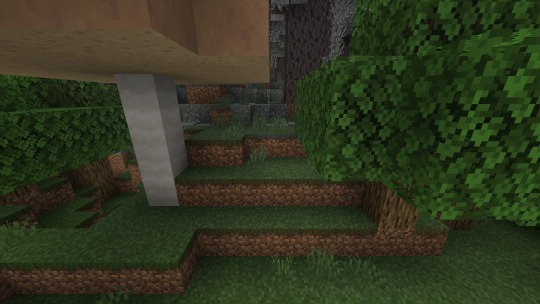
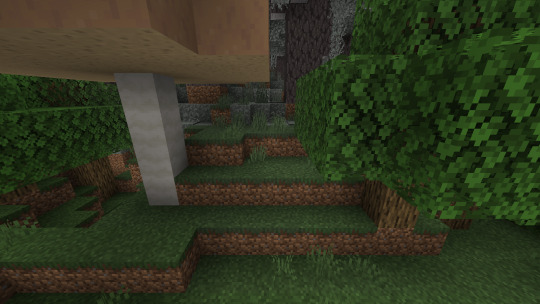
it isn't perfect, but that's mostly because minecraft's biome blending as a whole isn't perfect.
also, i only included the colors for transitions to dark forests, birch forests and groves, since i'm contemplating increasing the number of colors for each biome transition again. that'd be a lot of work for something that i don't even know if it'll be more accurate, so i haven't yet come to a decision, but once i do, i will finish the pale garden biome transitions.
these are the only transitions i even found generating naturally anyway, and bedrock edition does not yet have /fillbiome, so this shouldn't be noticeable in-game, but if it is, i would appreciate if people told me.
i fixed the issue this pack was having with cobblestone walls, as i said i would.
i removed the textures for the different types of nether bricks, since vanilla fixed their issue, but to match them (and other kinds of bricks), i shifted the texture for mud bricks over a pixel to the left, so that the stuff in between the bricks (i forgor what it's called) is on the right side.


in very early versions, this pack and Conglomeration were initially meant to be one and the same, but that ended up getting changed. while a bunch of features got removed in favor of just having them in conglomeration, bedrock edition's green item slot highlight is just really ugly, and so the java-edition-styled highlights stayed in the pack for a long time, up until their removal in Beta 5.
i reverted that back.
turns out, the green slot highlight, apart from being really ugly, is also really difficult to work with from a creative perspective. particularly, in the crafter screen and the new bundle tooltip (bundle ui changed slightly in game version 1.21.50).
so i re-implemented all the JE-styled highlights i had from Beta 4. (i also reverted the changes to the buttons on the beacon screen, since those use the same color palette). there were some small changes to the json, but those aren't super important. what is important is that these changes meant i had to start paying attention to the bundle ui, which, of course, is off center. so i fixed that.
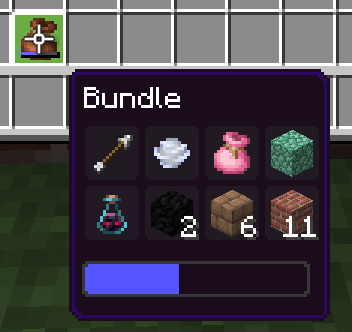
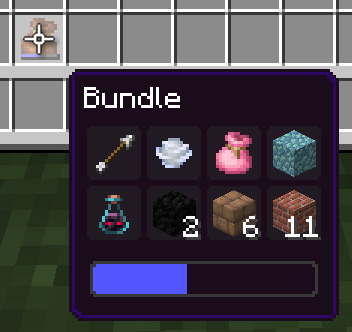
sidenote, but you ever notice that light blue and light gray bundles have long enough names to stretch the ui?? java edition has its bundle ui pre-stretched to deal with this, which is kinda silly imo.
anyway, i also did the highlight inside the bundle ui:
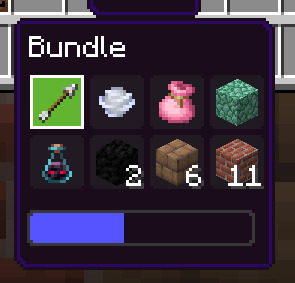
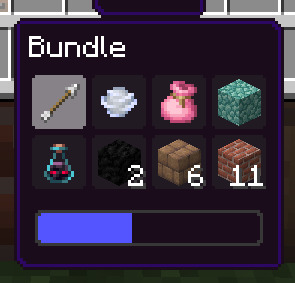
this is mostly accurate to java edition, except the slot background doesn't disappear when the highlight is visible, since the background of the tooltip is already opaque (and therefore inaccurate) anyway.
this uses two different textures (directly adapted from the java edition textures) because i couldn't get it accurate otherwise, but it might still be technically better optimized than vanilla, since it isn't needlessly checking whether touch controls are being used (selecting an item with touch controls instantly closes the bundle ui).
speaking of which, i also fixed bundles with pocket ui.
i'm holding off on pocket ui until the end of this pack's development, but i figured since i'm already here and pocket bundles are in the same file as classic bundles, i might as well.

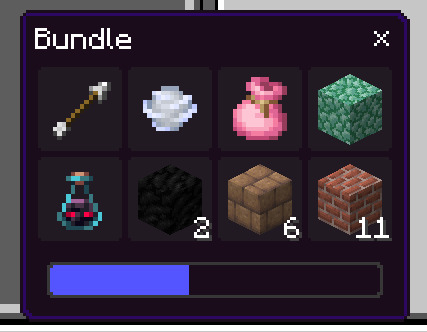
aaaaand before we leave bundle land, i just want to say that Beta 5 has an issue where a closed bundle is visible behind the open bundle when scrolling through a bundle's contents in a crafting grid specifically. i don't have an installation of Beta 5 right now to show this off with, but i fixed it.
one of my favorite parts of this pack is the way it changes the recipe book (/creative inventory). in vanilla, as with the rest of the ui, things are just kinda scaled willy nilly. the scrolling part of the recipe book doesn't quite fit into the space allotted, but this pack fixes that. (would you believe me if i said it was difficult? you shouldn't, because that would be me lying.)
one of the things this pack neglected to fix previously was the length that the recipe book scrolls. in vanilla, as with some other parts of the ui, the recipe book scrolls down farther than it should, leaving a noticeable gap between the buttons and the bottom of the scrolling area.
i didn't previously have any idea what the issue was on account of scrolling panels being complicated, but i've since messed around with dropdowns, learning a lot about scrolling in the process. the issue was the exact first thing i thought to check. mojang should be ashamed.
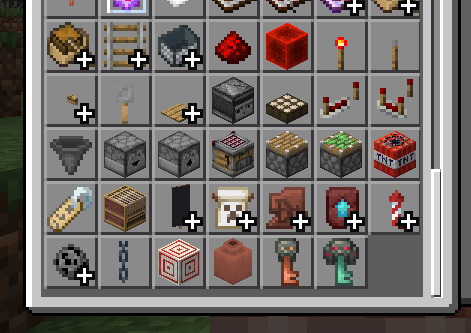
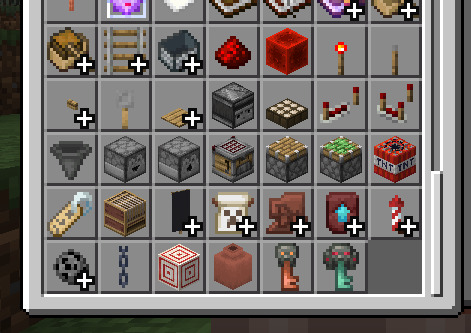
Holy Shit It's So FUCKING SNUG!!!!!!!
last things last, mojang added an option to the GUI Log Level dropdown in the settings screen, making it scroll. this pack previously made it not be considered scrolling, since it didn't scroll before, but now that it does, this change has been reverted, with the fixes for scrolling dropdowns now in effect.
#minecraft#minecraft bedrock#minecraft resource pack#cornbread does a devlog#cornbread's texture fixer#id in alt
5 notes
·
View notes
Text
Normally I just post about movies but I'm a software engineer by trade so I've got opinions on programming too.
Apparently it's a month of code or something because my dash is filled with people trying to learn Python. And that's great, because Python is a good language with a lot of support and job opportunities. I've just got some scattered thoughts that I thought I'd write down.
Python abstracts a number of useful concepts. It makes it easier to use, but it also means that if you don't understand the concepts then things might go wrong in ways you didn't expect. Memory management and pointer logic is so damn annoying, but you need to understand them. I learned these concepts by learning C++, hopefully there's an easier way these days.
Data structures and algorithms are the bread and butter of any real work (and they're pretty much all that come up in interviews) and they're language agnostic. If you don't know how to traverse a linked list, how to use recursion, what a hash map is for, etc. then you don't really know how to program. You'll pretty much never need to implement any of them from scratch, but you should know when to use them; think of them like building blocks in a Lego set.
Learning a new language is a hell of a lot easier after your first one. Going from Python to Java is mostly just syntax differences. Even "harder" languages like C++ mostly just mean more boilerplate while doing the same things. Learning a new spoken language in is hard, but learning a new programming language is generally closer to learning some new slang or a new accent. Lists in Python are called Vectors in C++, just like how french fries are called chips in London. If you know all the underlying concepts that are common to most programming languages then it's not a huge jump to a new one, at least if you're only doing all the most common stuff. (You will get tripped up by some of the minor differences though. Popping an item off of a stack in Python returns the element, but in Java it returns nothing. You have to read it with Top first. Definitely had a program fail due to that issue).
The above is not true for new paradigms. Python, C++ and Java are all iterative languages. You move to something functional like Haskell and you need a completely different way of thinking. Javascript (not in any way related to Java) has callbacks and I still don't quite have a good handle on them. Hardware languages like VHDL are all synchronous; every line of code in a program runs at the same time! That's a new way of thinking.
Python is stereotyped as a scripting language good only for glue programming or prototypes. It's excellent at those, but I've worked at a number of (successful) startups that all were Python on the backend. Python is robust enough and fast enough to be used for basically anything at this point, except maybe for embedded programming. If you do need the fastest speed possible then you can still drop in some raw C++ for the places you need it (one place I worked at had one very important piece of code in C++ because even milliseconds mattered there, but everything else was Python). The speed differences between Python and C++ are so much smaller these days that you only need them at the scale of the really big companies. It makes sense for Google to use C++ (and they use their own version of it to boot), but any company with less than 100 engineers is probably better off with Python in almost all cases. Honestly thought the best programming language is the one you like, and the one that you're good at.
Design patterns mostly don't matter. They really were only created to make up for language failures of C++; in the original design patterns book 17 of the 23 patterns were just core features of other contemporary languages like LISP. C++ was just really popular while also being kinda bad, so they were necessary. I don't think I've ever once thought about consciously using a design pattern since even before I graduated. Object oriented design is mostly in the same place. You'll use classes because it's a useful way to structure things but multiple inheritance and polymorphism and all the other terms you've learned really don't come into play too often and when they do you use the simplest possible form of them. Code should be simple and easy to understand so make it as simple as possible. As far as inheritance the most I'm willing to do is to have a class with abstract functions (i.e. classes where some functions are empty but are expected to be filled out by the child class) but even then there are usually good alternatives to this.
Related to the above: simple is best. Simple is elegant. If you solve a problem with 4000 lines of code using a bunch of esoteric data structures and language quirks, but someone else did it in 10 then I'll pick the 10. On the other hand a one liner function that requires a lot of unpacking, like a Python function with a bunch of nested lambdas, might be easier to read if you split it up a bit more. Time to read and understand the code is the most important metric, more important than runtime or memory use. You can optimize for the other two later if you have to, but simple has to prevail for the first pass otherwise it's going to be hard for other people to understand. In fact, it'll be hard for you to understand too when you come back to it 3 months later without any context.
Note that I've cut a few things for simplicity. For example: VHDL doesn't quite require every line to run at the same time, but it's still a major paradigm of the language that isn't present in most other languages.
Ok that was a lot to read. I guess I have more to say about programming than I thought. But the core ideas are: Python is pretty good, other languages don't need to be scary, learn your data structures and algorithms and above all keep your code simple and clean.
#programming#python#software engineering#java#java programming#c++#javascript#haskell#VHDL#hardware programming#embedded programming#month of code#design patterns#common lisp#google#data structures#algorithms#hash table#recursion#array#lists#vectors#vector#list#arrays#object oriented programming#functional programming#iterative programming#callbacks
20 notes
·
View notes
Text
Blackbird Spyplane
Too many places are STERILE and TORCHED — let’s make them COOL and FUNKY
In praise of Un-Grammable Hang Zones (U.G.H.Z.)
Right now, in year ~15 of the fetish for “clean lines” and “understated elegance,” I wanna hang for hours in a FRUMPY, MISSHAPEN, INVITINGLY INELEGANT place like Jump’N Java instead, during which time I would never even think to take out my phone and let the feed know I was there because, despite being packed with vibey curios, the place is way too much of a CHAOTIC VISUAL HODGEPODGE to “work” in the form of an iPhone pic on social media … There is one major flaw with U.G.H.Z — the food and drinks on offer typically range from passable to abysmal !
Your clothes are haunted by beautiful ghosts
3. Relatedly, clothes can be haunted by ghosts — in a way that is not spooky but tight — and rocking them can be séance-like. Memories of your past selves get woven into the threads of a favorite t-shirt you wore throughout college or a rainshell you wore in the backcountry. The spectral afterglow of other people’s lives lingers in secondhand pieces, too, which is why it feels so transportive when you buy, e.g., a secondhand jacket and find an old plane ticket or handwritten shopping list or letter tucked in the pocket. The pockets can be empty, too, and the s**t can still be full of ghosts.
Cool clothes should have credit sequences
The pleasures of "C.R.E.D.I.T.S. Mindset" Collaboration Respecters Enjoy Deeper Immersion in the Tightest S**t !! The answer to 3. is illustrated nowhere better than the way N*tflix (and other streaming platforms) make it actively hard to NOT skip end credits these days… They play a few pro forma seconds, then suddenly the window minimizes and the algorithm tries to serve you up some other st INSTANTLY, on autoplay... Just appreciating the visual representation, as name after name goes by, of the fact that MAD PEOPLE besides the director, writer & actors worked to make the thing I just watched — a collectivist counterbalance to romantic yet pernicious myths of INDIVIDUALIST GENIUS that can make us focus disproportionately on “numero uno” at the expense of fellowship & communitarian obligations! (This also manifests in a cool way when you see a filmmaker’s “Thank Yous” and get a little glimpse of the “social architecture” of a film’s making, like, “Dmn I didn’t know Joanna Hogg was homies with Martin Scorsese, that’s tight.”) ... Reading mad fashion magazines — which Erin has been doing since she was a COOL KID conducting adolescent jawn-recon — and whipping yr eye back and forth between the pics and the GUTTER CREDITS, where the info on designers, models, stylists, photographers, etc. is tucked. C.R.E.D.I.T.S. Mindset can be seen in opposition to marketing — because shining a light on otherwise unacknowledged labor can help reveal endemic exploitation (or, say, wildly inflated pricing). But it can abet marketing, too, for worse or better, whether via mockable clichés (“tonight’s chicken was raised 22 miles north of here by a farmer named Carol whose grain-free feed consists of …”) or by explaining and justifying something’s relatively high price tag by letting you know how, e.g., a pricey artisan jawn’s making was materially different from that of a cheap s*tty mass-market jawn.
By “blessed uninterrupted closed system” what we mean is that:
Nothing entered the room that wasn’t already there (e.g., no hot takes, no tweets, no IG stories, no “streaming content”) and
Nothing went out (no data for advertisers to vacuum up, no fuel for the algorithm to ingest, no performed versions of ourselves for the timeline to behold.) This was like that baller ROOM OF ONE’S OWN s*t Virginia Woolf was talking about, baby… And g-d dmn, it felt great!!
Is Ssense hurting the cool-clothes ecosystem? https://www.blackbirdspyplane.com/p/is-ssense-hurting-the-cool-clothes-ecosystem
2 notes
·
View notes
Text
Yeah so unfortunately for the masochists (me) you may never see this seed again, let alone play it:
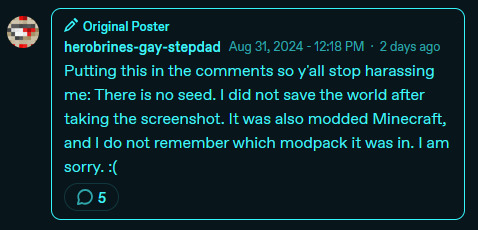
Considering we know this was a modded seed but don't know what mods were in it, anyone trying to find this seed will have an even rougher time than if this were pure vanilla...
But! That isn't to say you can't get your Awful Survival Island fix!
There's one that I had discovered a while back, and it's arguably worse if you can imagine that.
Here's seed 2002795318716922593:
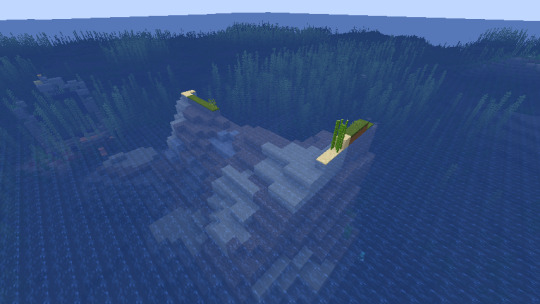
Yep. That's where you spawn.
Your nearest tree is hundreds of blocks away - but of course, going that far to set up your base on actual land kinda defeats the purpose of the challenge. No, you're gonna have to find some other way to get wood here. (Hint: it's not the Nether portal off to the left. You might find some golden tools at least?)
Good luck :)
This seed works in Java Edition 1.21.1 (the current version as of posting this), but the Bedrock Edition version of this seed gives you something much too different. It's... weird. If you're curious, you can see more about it under the "keep reading" label.
(also yeah haha seed woo out-of-context comedy. anyways enjoy suffering in funny block game. or don't. it's up to you)
Like. Just look at it:
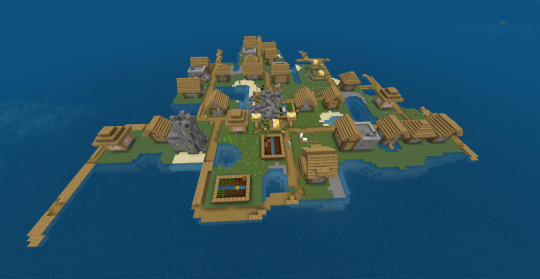
I was expecting to just be shunted onto some bigger plot of land when I booted up this seed in Bedrock Edition, not... this. You can really tell this village didn't generate on top of land or anything, too. There's, what, 3 or 4 layers of blocks before you find nothing but water beneath this village.
Also there's a random ocean ruin structure in the middle of it?? I know there's still quite a few differences between Java and Bedrock, but I don't think that's one of them?
This is an interesting seed in and of itself, but it's far from the masochistic paradise that this seed's Java Edition counterpart is. Not the original point of my reblog, so that's why it's stuck in Keep Reading Limbo™.

yeah ok thats probably the biggest "fuck you" of a spawn point ive ever gotten
#minecraft#images from my reblog have IDs/alt text; remaining images don't have IDs/alt text#i found this seed from a youtube video a while back but unfortunately i don't remember the exact vid. sorry lol#(should i tag this as my usual suggestive “sus text” tag? ...nah. don't feel like it)
31K notes
·
View notes
Text
Want to develop a high-performance large-scale web application? You may probably get benefitted with Memcached distributed caching solution. Memcached is a popular distribute caching system. It is developed using PHP but available to use in all popular languages including Java, Python, and Ruby. It was developed by Brad Fitzpatrick in 2003 and has been heavily used in PHP applications after that. Memcached is very simple to use. It can store a key value pair in memory for fast retrieval. The Memcached API offers methods to manipulate and fetch data easily. Serious Memcache users may also want to check out these books on Memcached. This article provides a very high-level overview of Memcached system and its benefits. How Does Memcached Work? Memcached has a distributed caching architecture that relies on sharding of keys. Each key is stored in a dedicated shard that may be backed by one or more machines. This approach helps us scale better for caching really large amount of data. A single machine can cache only up to its RAM limit. Whereas in the case of Memcached you can add many machines to your system and cache really large amount of data. The design of Memcached abstracts the storage from API users, so the usage of the system is very simple. The application user need not worry about the complex logic it uses to divide keys between different machines. It guarantees that a provided key will be stored and retrieved without user knowledge about where it is stored. Can It Be Used Only For Web Applications? Memcached is usage in a web application is very common. However, its design does not limit it to be used in only web applications. You can use it in any application software where distributed caching can help. The key idea is to avoid IO and server data direct from RAM. Why Is Memcached Popular? Memcached is very popular among web applications. Below are some key benefits of using a distribute caching solution like Memcached. Much faster application since IO is reduced and most data is served from RAM. Better use of RAM - A lot of RAM may be left unused on multiple servers. You can easily add these machines as nodes to Memcached system and start making use of it. The application can scale out instead of scale up. Practical Scenarios Where Memcached Can Be Used Below are some practical scenarios where people have used Memcached successfully. Serving relatively static data that changes infrequently but gets read a lot. E.g. Blogs, Websites with dynamic pages that are generated, User profile pages etc. Preventing weak passwords attack. I will describe this in a separate blog post sometime this month. Page elements of websites can be cached that do not really change in the application lifecycle. There may be large tables in your relational database that are accessed often with a primary key. This access can be minimized by caching most common query results in Memcached. Who Is Using Memcached? Memcached is a popular library and used by thousands of apps. Below are some popular names that use Memcached. Apple Craigslist Wikipedia Flickr Wordpress Areas Of Concern About Memcached Memcached is a highly scalable solution however, it has some areas of concern that you need to be aware. It stores all data in RAM. This makes it fast, however, it also makes it easy to loose. This data is never persisted to a storage system. If there is a power loss or server crash, you will lose all your data in Memcached. Since it is always in RAM, you need to initialize the cache after every restart. This may require extra programming awareness towards serving data from cache or storage. Since it's not persisted in any storage, the application developer must take the onus of persisting and updating data for all scenarios. All CRUD (Create, Read, Update, Delete) scenarios must be considered while designing your system with Memcached. Memcached does not support transactions, this may be a big consideration if you are trying to cache transactional data.
It can be CPU intensive mainly due to generating a lot of garbage in memory. What Are Memcached Alternatives? Below are some alternatives to Memcached that you can consider using for highly scalable applications. Redis Redis is an open source in-memory caching solution with a lot many more features as compared to Memcached. It has support for data structures such as strings, list, and sets. Couchbase Couchbase is a leading noSQL database that is built on top of Memcached. It has enhanced features for persistent storage and low latency. There are other alternatives catching popularity in recent years. See below google trends. Summary Memcached is a powerful system and many applications are able to get faster response time with it. Are you using it? Please share your feedback about it in comments.
0 notes
Text
Top Spring Boot Interview Questions and Answers (2025 Edition)

Spring Boot has become the standard for building production-ready Java applications with minimal configuration. If you're preparing for a backend or full-stack developer role, having a good grip on common Spring Boot interview questions is a must.
In this post, we’ll walk you through the most frequently asked Spring Boot questions to help you ace your next interview.
📘 Want a complete list with detailed answers and code examples? 👉 Read the full guide here: Spring Boot Interview Questions – Freshy Blog
🔹 What is Spring Boot?
Spring Boot is an extension of the Spring framework that simplifies the development of Java-based applications by providing auto-configuration, embedded servers, and production-ready defaults.
🔸 Common Spring Boot Interview Questions
1. What are the main features of Spring Boot?
Auto Configuration
Starter Dependencies
Spring Boot CLI
Actuator
Embedded Web Servers (Tomcat, Jetty)
2. What is the difference between Spring and Spring Boot?
Spring Boot is a rapid application development framework built on top of Spring. It eliminates boilerplate configuration and helps developers get started quickly.
🔸 Intermediate Spring Boot Questions
3. What are Starter dependencies?
Starter dependencies are a set of convenient dependency descriptors that you can include in your application. For example:
<dependency>
<groupId>org.springframework.boot</groupId>
<artifactId>spring-boot-starter-web</artifactId>
</dependency>
4. What is Spring Boot Actuator?
Spring Boot Actuator provides production-ready features like monitoring, metrics, and health checks of your application.
🔹 Advanced Spring Boot Questions
5. How does auto-configuration work in Spring Boot?
Spring Boot automatically configures your application based on the dependencies you have in your classpath using @EnableAutoConfiguration.
6. How can you secure a Spring Boot application?
You can use spring-boot-starter-security and configure it with annotations like @EnableWebSecurity, along with custom authentication and authorization logic.
🔍 More Questions Covered in the Full Guide:
What are Profiles in Spring Boot?
What is the role of application.properties or application.yml?
How to implement exception handling in Spring Boot?
How to integrate Spring Boot with databases like MySQL, PostgreSQL?
👉 Get full coverage with examples, tips, and best practices: 🔗 https://www.freshyblog.com/spring-boot-interview-questions/
✅ Quick Tips for Spring Boot Interviews
Understand how dependency injection works
Be familiar with REST API development in Spring Boot
Practice building microservices
Explore Spring Security basics
Review annotations like @RestController, @Service, @Component, and @Repository
Final Thoughts
Mastering these Spring Boot interview questions can give you a solid edge in any technical interview. As Java continues to be a dominant backend language, Spring Boot remains a vital tool in the modern developer’s toolkit.
📘 Want to dive deeper? 👉 Visit the full interview question guide here: Spring Boot Interview Questions – Freshy Blog
#SpringBootInterviewQuestions#JavaDeveloper#SpringFramework#BackendDevelopment#TechInterviews#JavaJobs#SpringBootTips#FreshyBlog#InterviewPrep2025#SpringBoot2025#tech#technology
0 notes
Text
Accelerate Your Project with Kotlin App Development

In today’s fast-paced digital world, speed and quality are paramount in mobile development. Kotlin App Development It has become a go-to solution for startups and enterprises alike who want to launch apps quickly without compromising performance. Whether you're a business looking to hire expert developers or exploring cost-effective solutions, Kotlin offers the perfect balance between speed, functionality, and scalability.
Kotlin, officially supported by Google for Android development, is a statically typed programming language that integrates seamlessly with Java. Its concise syntax, safety features, and powerful tooling drastically reduce development time. That’s why more businesses are turning to Kotlin App Development Companies to build robust, maintainable apps faster than ever.
Why Choose Kotlin for App Development?
Kotlin is not just a trend—it’s a strategic advantage. Its modern syntax allows developers to write less boilerplate code, which speeds up the build process and reduces bugs. Compared to traditional Java development, apps written in Kotlin are typically more reliable and easier to maintain.
If you're considering Kotlin App Development in India, you’ll find a vast talent pool of developers skilled in creating scalable mobile apps. India has become a hub for outsourcing development services, offering top-tier expertise at competitive prices.
Benefits of Kotlin App Development Services
Partnering with a Kotlin App Development Company ensures that you get access to:
Faster time-to-market: Build and deploy apps quicker than with legacy languages.
Cross-platform compatibility: Kotlin Multiplatform allows code sharing across Android, iOS, and web.
Strong community and support: Ongoing improvements and support from JetBrains and Google.
Clean and safe code: Reduce crashes and errors with Kotlin’s null safety and smart casting.
These benefits make Kotlin an ideal choice for businesses wanting scalable and stable solutions without unnecessary overhead.
Book an Appointment with Kotlin Experts Today
Whether you're a startup with an MVP or an enterprise scaling your mobile ecosystem, hiring Kotlin App Development developers can dramatically reduce your development cycle. Schedule a call to discuss how we can turn your idea into a high-performing app using Kotlin.
How Much Does Kotlin App Development Cost?
The Kotlin App Development cost depends on various factors like app complexity, features, design needs, and platform support. On average, a simple Kotlin-based app may cost anywhere from $10,000 to $25,000, while more advanced applications could exceed $50,000. However, with Kotlin’s efficiency, many businesses see a lower total cost of ownership in the long run due to faster delivery and fewer maintenance issues.
By working with leading Kotlin App Development Companies, you not only get access to technical talent but also expert project management and quality assurance practices that ensure your app is delivered on time and within budget.
Choosing the Right Kotlin App Development Company
To ensure project success, look for a partner that offers a full-stack Kotlin App Development Service—from ideation and UI/UX design to testing and post-launch support. Here’s what to consider:
Experience in building Kotlin apps across industries
Transparent communication and agile workflows
Portfolio of successful Kotlin projects
Customizable Kotlin App Development Solutions based on your business goals
India remains a preferred destination for many businesses looking to hire Kotlin App Development developers, offering a blend of affordability and innovation.
Conclusion
Kotlin has redefined mobile development by enabling faster, cleaner, and more scalable applications. Whether you're building a consumer app or an enterprise tool, choosing the right Kotlin App Development Services can make all the difference. Don't let delays slow your growth—embrace the Kotlin advantage and launch your app in half the time.
0 notes
Text
Web Development vs App Development: Which is Better for Beginners?
In today’s digital era, two of the most in-demand career paths areweb development and app development. Whether you are a student, a freelancer, or someone looking to transition into tech, understanding the differences between these two fields can help you make an informed choice. If you're also considering building a personal brand or sharing your tech journey, you might be wondering how to start blogging in India. Let’s explore both topics together.
Web Development vs App Development
Web development involves building websites and web applications that run on browsers. It includes front-end development (HTML, CSS, JavaScript) and back-end development (PHP, Node.js, Python, etc.). Web developers focus on creating responsive, accessible, and SEO-friendly websites.
App development, on the other hand, refers to building mobile applications that run on smartphones and tablets. These apps can be for Android (Java, Kotlin) or iOS (Swift, Objective-C), or even cross-platform using Flutter or React Native.
Pros of Web Development:
Easier to get started; many online tutorials and free resources are available.
Greater flexibility with freelance and remote jobs.
One codebase works across platforms (thanks to responsive design).
Pros of App Development:
High demand in the mobile-first world.
Better integration with device hardware (camera, GPS, etc.).
Often pays more for specialized roles.
If you're just starting out, web development might be a better entry point due to its simplicity and lower hardware requirements. However, if you're excited about mobile technology and want to build user-friendly apps, app development is equally rewarding.
How to Start Blogging in India
No matter which path you choose, documenting your journey can be powerful. Blogging not only helps you reinforce your learning but also builds your online presence.
Here’s how to get started:
Choose a Niche: Whether it's web development, app development, or tech tips, pick a focus area you're passionate about.
Pick a Platform: Use platforms like WordPress, Blogger, or Medium. For more control, you can self-host your blog using WordPress.org.
Buy a Domain: Invest in a custom domain (e.g., yourname.in) to look professional.
Create Quality Content: Share tutorials, case studies, and project experiences. Use keywords naturally, like “Web Development vs App Development,” to attract traffic.
Promote Your Blog: Share your posts on LinkedIn, Twitter, and tech forums. Engage with readers and other bloggers.
Conclusion
Whether you choose web development vs app development, both offer exciting career opportunities. And by learning how to start blogging in India, you can amplify your voice, attract job offers, or even monetize your knowledge. Start small, stay consistent, and let your digital journey unfold.
0 notes
Text
How Startups and Enterprises Can Find the Best App Development Companies in India
Introduction
Looking to create the next big mobile app? Whether you're a startup founder or a corporate IT lead, finding one of the best app development companies is the first big step. With so many agencies out there, the process can feel overwhelming. But don’t worry — this guide will help you narrow it down with clear, simple advice.
What Makes a Great App Development Company?
Not every firm is the same, and not all of them will suit your goals. Here’s what to look for:
1. Strong Technical Skills
Your app needs to work across devices, screen sizes, and platforms. The company should be skilled in technologies like:
React Native and Flutter for cross-platform apps
Kotlin or Java for Android
Swift for iOS
Also, they should know how to integrate APIs, use cloud services, and build scalable architectures.
2. Relevant Industry Experience
You want someone who understands your business space. For example:
A custom app developer with experience in retail apps knows how to implement payment gateways.
Someone familiar with health apps understands data security compliance.
Ask: “Have you built apps similar to ours before?”
How Do They Handle Project Management?
Working with a team that communicates well is just as important as coding. Look for:
Clear development timelines
Tools like Jira, Trello, or Slack for updates
Weekly review meetings
A well-organized app development agency will walk you through each phase — from idea to launch.
Onshore vs. Offshore Development: Which is Better?
Let’s explore what suits Indian businesses better:
Onshore (India-based companies):
No time zone difference
Easier collaboration and language alignment
Better understanding of Indian user behavior
Offshore (e.g., US, UK companies):
May offer broader global insights
Often more expensive
Time zone lag may slow communication
If you're based in India, partnering with one of the best app development companies within the country often gives you the perfect balance of quality and affordability.
Key Questions to Ask Before You Hire
What is your experience with apps like mine?
Can I speak to previous clients?
Do you offer end-to-end development — from planning to post-launch support?
What happens if we need future updates or fixes?
Getting clear answers builds trust and prevents surprises later.
Startup Story: Making the Right Choice
A Pune-based EdTech startup was confused between a large agency and a boutique firm. The larger company was more expensive but had lots of projects. The smaller team offered personalized support, quick feedback loops, and deep involvement in ideation. They chose the smaller one — and launched in 3 months with 50K downloads in the first quarter.
The takeaway? It's not always about size — it's about compatibility.
Red Flags to Watch Out For
When exploring app partners, don’t ignore these signs:
No NDA or confidentiality agreement
Too cheap pricing (you get what you pay for)
No clear deliverables or contract terms
Unclear ownership of the app’s source code
These are signs that the company may not be reliable long-term.
Conclusion
When it comes to choosing the best app development companies, there’s no one-size-fits-all answer. It’s about finding a team that understands your goals, communicates clearly, and brings technical excellence to the table.
Do your homework, compare options, and always trust your instincts.
Need Help With Your App?
Contact us to get a free consultation for your app idea. Let’s turn your idea into a product users love!

1 note
·
View note
Text
Engineering Excellence: How EDSPL Delivers End-to-End Software Development Services That Drive Business Growth

Introduction: The Power of Software in a Digital-First World
In today’s digital economy, the right software can be the difference between growth and stagnation. Every business, whether a startup or a large enterprise, requires technology that not only solves current challenges but also scales with future demands. That’s where EDSPL (Enrich Data Solutions Pvt. Ltd.) steps in — a name synonymous with engineering excellence and customized, end-to-end software development services that drive real business outcomes.
From ideation to deployment and ongoing support, EDSPL’s software solutions are designed to empower enterprises across industries to streamline operations, enhance customer experiences, and gain a competitive edge.
Why End-to-End Software Development Matters
Businesses today cannot afford fragmented solutions or patchwork technology. What they need is a cohesive, full-lifecycle software approach — something that starts with understanding their unique needs and ends with a robust, future-ready product. EDSPL’s end-to-end services ensure that businesses don’t just get software — they get a digital foundation for growth.
Here’s how EDSPL makes it happen:
1. Understanding Business Goals First, Then the Code
At EDSPL, every successful project begins with empathy and clarity. Before writing even a single line of code, EDSPL’s business analysts and technical consultants engage deeply with clients to understand:
What is the business problem?
Who are the users?
What are the short- and long-term goals?
What does success look like?
This discovery phase ensures that the final product is not just technically sound, but aligned with core business objectives.
2. Agile Methodologies for Rapid, Responsive Development
Today’s market demands speed, flexibility, and user feedback loops. EDSPL uses Agile and DevOps practices to deliver iterative progress, allowing clients to see tangible results early on and refine requirements as needed.
Benefits of EDSPL’s agile development process:
Faster time to market
Transparent communication
Real-time progress tracking
Adaptability to change
Whether it’s a Minimum Viable Product (MVP) for a startup or a complex enterprise platform, the approach remains nimble, collaborative, and client-centric.
3. Tailor-Made Solutions — Not Templates
Every business is different — and so are its technical needs. Unlike companies that use rigid, one-size-fits-all frameworks, EDSPL builds custom software tailored to:
Specific industry demands (Finance, Healthcare, Retail, Manufacturing, etc.)
Integration with existing infrastructure
Scalability needs
User experience preferences
This personalized approach ensures that the software fits the business like a glove, instead of forcing the business to change for the software.
4. Cross-Platform Expertise That Scales
Whether it’s web, mobile, or cloud, EDSPL’s engineering teams have the skillsets to build applications that work seamlessly across platforms. Technologies include:
Front-end: React, Angular, Vue.js
Back-end: Node.js, Python, Java, .NET
Mobile: Android (Kotlin), iOS (Swift), Flutter, React Native
Cloud & DevOps: AWS, Azure, Docker, Kubernetes, CI/CD pipelines
EDSPL ensures that the tech stack is not only modern and secure but also scalable to support future growth.
5. Quality Assurance at Every Stage
At EDSPL, quality is not a phase — it’s a culture. QA specialists are involved right from the requirement stage to post-deployment. Every module is tested rigorously through:
Manual Testing
Automated Testing
Performance & Load Testing
Security Audits
This attention to detail ensures bug-free, robust applications that meet industry standards and client expectations.
6. Ongoing Support and Evolution
Software development doesn't stop after launch — and neither does EDSPL’s partnership. The company offers comprehensive post-deployment support, including:
Regular maintenance
Security patches
Performance tuning
Feature upgrades
Clients can also opt for dedicated support teams to ensure round-the-clock system availability and seamless performance.
7. Data-Driven Decisions with Smart Analytics Integration
Modern businesses need insight-driven software that goes beyond functionality to offer valuable intelligence. EDSPL integrates smart analytics dashboards and reporting engines that help clients track:
User behavior
System performance
Operational KPIs
ROI of the application
These insights drive continuous improvement and smarter business decisions.
8. Security Is Built In, Not Bolted On
In an era of rising cyber threats, security can’t be an afterthought. EDSPL embeds security practices throughout the SDLC (Software Development Life Cycle):
Secure coding practices
Role-based access controls
Data encryption
Regular VAPT (Vulnerability Assessment and Penetration Testing)
Compliance with GDPR, HIPAA, PCI DSS depending on industry
This ensures peace of mind and regulatory compliance from day one.
9. Proven Track Record Across Industries
EDSPL has successfully delivered high-impact software projects across various domains:
Banking & Finance: Fintech platforms, loan management systems
Healthcare: EMR/EHR systems, patient portals, health analytics
Retail & eCommerce: Inventory solutions, mobile shopping apps, CRM tools
Education: Learning Management Systems (LMS), exam platforms
Manufacturing: ERP modules, logistics automation
This diverse experience equips the team to bring cross-industry innovation to every project.
10. Humanized Collaboration – The EDSPL Difference
While the technology is cutting-edge, the EDSPL team never loses the human touch. Clients describe the engagement as:
“Working with a true partner, not just a vendor.”
Transparent communication, proactive suggestions, collaborative brainstorming, and a shared focus on success make EDSPL a preferred technology partner for businesses looking to scale.
Business Benefits of Partnering with EDSPL
When you choose EDSPL, you’re not just choosing a software development company — you’re choosing:
✅ Faster product development ✅ Reduced go-to-market time ✅ Software that evolves with your business ✅ Stronger customer engagement through seamless digital platforms ✅ Technology that supports your revenue goals
Client Success Snapshot: Transforming an Offline Retailer into an Omnichannel Powerhouse
One of EDSPL’s standout projects involved working with a mid-sized Indian retailer that wanted to go digital. The client needed:
A customer-facing mobile app
Integration with existing inventory software
Secure payment gateway
Loyalty program integration
Real-time reporting dashboard
EDSPL delivered a full-featured solution within six months, resulting in:
40% increase in online sales
25% improvement in customer retention
Streamlined warehouse operations with real-time stock updates
This is just one of many success stories that demonstrate EDSPL’s commitment to business impact through smart software engineering.
Conclusion: Software That Doesn’t Just Work — It Wins
In a world where software determines customer experience, operational efficiency, and competitive edge, businesses need more than just code. They need a partner who understands their vision, challenges, and potential — and turns that into digital reality.
EDSPL does exactly that.
With a focus on engineering excellence, custom solutions, and client-centric collaboration, EDSPL continues to be the preferred software development partner for businesses that want to grow smart and scale fast.
Ready to Build Something That Moves Your Business Forward?
Let’s talk. Visit www.edspl.net and discover how EDSPL’s end-to-end software development services can turn your ideas into powerful digital solutions.
Please visit our website to know more about this blog https://edspl.net/blog/engineering-excellence-how-edspl-delivers-end-to-end-software-development-services-that-drive-business-growth/
0 notes
Text
I'd like to add to this, though it's a bit tangential — there's also some pretty fundamental skills that exist in both STEM and humanities, and being able to make the connections between how they exist in these separate fields can really help your comprehension in either or both categories.
I'll have to apologize in advance because this post got way, way longer than I intended, and it's a fair bit messy and all over the place. But I do try and tie it back in to this original post, even if it takes a hot minute to get there >.>
.
I'm no longer in STEM at the moment but I did take a handy amount of both STEM and humanities courses, and ultimately chose the humanities route. Despite focusing on the humanities, there's definitely some STEM ideas that I found really useful in life, and by far the #1 has probably been the idea of abstraction.
For instance, when you say "abstract" there's a lot of things that can come to mind, with a common example being abstract art, right? Everyone knows the "crappy modern art" that's "overvalued" and "nonsensical" and whatnot. The funny-lookin' paint splatters on a canvas, or the giant blocks of solid color. That sort of thing.

Well, the word "abstract" is meant to represent the idea of something which exists separately from the real world. In contrast, the real stuff is described as being "concrete". The thing is that there's a spectrum of this stuff, with some things being more concrete but still a little abstract, and vice-versa.
Turns out that this is a REALLY important idea in computer science. Because computer chips work with 1s and 0s, and our silly primate brains ain't optimized to add a bajillion 1s and 0s. So instead, we use abstraction to describe collections of operations with these 1s and 0s: from the fundamental machine code that's binary operations only, to the "assembly language" that bridges the gap between binary numbers and human-readable characters, then to the higher-level programming languages.
We use highly-abstracted programming languages and write code like "a + b = c" but that has to be translated down into a more concrete code, the assembly language, and then that gets translated even further into the actual *real* operations happening on the transistors, the 1s and 0s.
And within a programming language we also use abstraction, such as in Java, an object-oriented programming language. You might take a block of code that has many different uses and describe it in a simple form as a class, then extend subclasses and give more concrete and specific definitions to that superclass.
A common and easy-to-understand example of this is Minecraft, with it's mobs, programmed in Java. There's a lot of things called "mobs", which are mobile entities that move themselves around and can interact with the player (and which the player can interact with). But some are aggressive, some are netural, some are passive— so how do you code all these different types of mobs?
What you can do is create an "abstract" class (not necessarily a literal "abstract class") for "mobs" in general, defining the most fundamental and simple traits (health bars, movement, dimensions, etc.) and then extend that class into specific examples. You might create a subclass for the "Passive mobs" that defines how they react to being hit by a player, with their frantic running around.
But then the "Hostile mobs" subclass has a separate and unique bit of code to describe how these mobs deal more damage. And then you can extend the "Hostile mobs" subclass into a "Skeleton" subclass to define ranged attacks that other mobs don't have, and so on.

You can work with varying levels of abstraction in your code, in order to meet different needs. By working at high levels of abstract you define wide and simple principles readily understood with less effort, and which can be more widely applied, and then begin to narrow down the code into more detailed sections for specific circumstances.
It turns out... that's EXACTLY how abstraction works in art. All the stuff you see in art exists on a spectrum from "abstract" to "concrete" and artworks are often made at some point on that spectrum to serve a specific purpose.
For example, you might want to visually depict a bird. On the most concrete level you have the human eye's vision of a bird, though even that is subjective: it's based on the physical health of one's eyesight, and the cultural expectations of what a "bird" is.
Then you have the photograph, which is still nearly exact concrete (hence "photorealistic") but still not 100% there. Then you have photorealistic art, and realistic, and then you go more and more abstract. You might move towards impressionistic art and pointillism, and then surreal art, and eventually you might arrive near total abstraction.
For instance, take this lovely photo of a Florida Scrub Jay (a very, very specific type of bird). This would be a rather concrete representation of a bird, and not just any bird but a particular species. Not a robin or raven or raptor, but a Florida Scrub Jay and nothing else!

(Photo from Wikimedia Commons)
Since that is a photo, it's pretty concrete to begin with. So to make it more abstract... I'll draw a quick study of it!
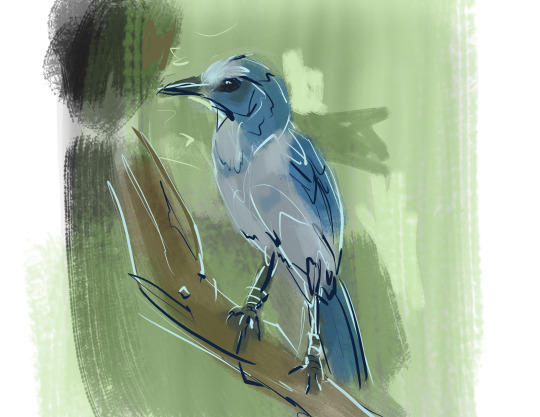
It's dirty and messy but gets the job done, I'm not making a 3-hour painted study for a tumblr post about STEM and humanities (and apparently birds, now). This took like... idk half an hour, 45 minutes? 15 minutes? I forgot to keep count and i've already put in like one and a half hours towards making this post by this point...
The drawing is still quite recognizable as being a Florida Scurb Jay, despite how messy it is, and you can also see the resemblance with the reference photo. It's farm from photorealistic, but it still has a strong level of concrete representation to it. It's far from true abstract art.
We can simplify things further, though, still staying representational but inching just a weeeee bit closer to the abstract:
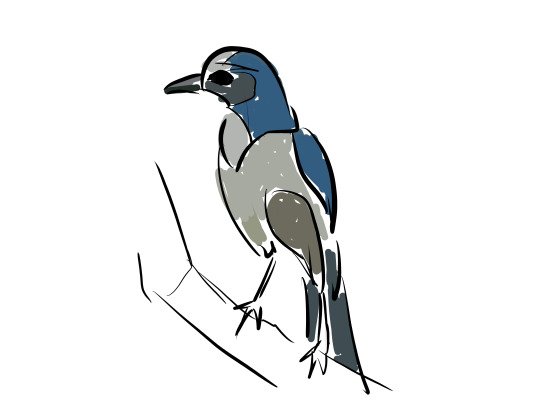

First we do away with the background, stick with some simply bold lines, and use big broad shapes with solid color. Then we simplify it even more, using only a few lines to indicate major forms, and using just four colors. No tree branch either. You can still recognize it as a Florida Scrub Jay though... right?
BUT WAIT! Another competitor has entered the ring! in the corner with the steel chair, it's...
the Blue Jay?!

(Once more, photo from Wikimedia Commons)
Turns out, we've abstracted far enough away from the original photo reference, that now our bird doodle seems to resemble BOTH the Florida Scrub Jay (Aphelocoma coerulescens) and this lovely Blue Jay (Cyanocitta cristata).
After all, both are birds which are white and blue, and have a roughly similar body proportion. The tails and wing feathers are both blue, and the heads both have blue. Most of the differentiation comes from details, like the rings of black on the Blue Jay's tail, or the white tuft of feathers atop the Florida Scrub Jay's head.
Well, guess what, folks? We can abstract even further!
First, let's do away with all those pesky colors. We only need the one blue, right? After all, both the Florida Scrub Jay and the Blue Jay can be called "blue birds" so why do we need white or gray?

But that's not a very attractive blue, is it? So... maybe we brighten it up a bit?
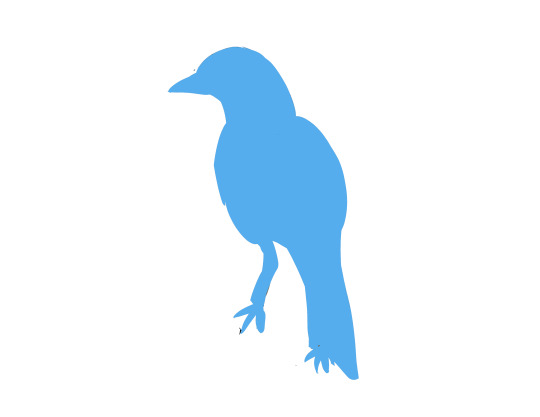
Aha! Now we're talking. But this pose is a bit... meh. Now that we've abstracted away so much detail, you can hardly tell it's a bird! especially with the wing tucked in and the tail overlapped with the leg.
Maybe we can just flip up the wing and tail? And let's open the beak for good measure, too, just to emphasize that it's a beak and not a sideways ice cream cone!

Hmmm... That's looking better. Say, our original photo was of a bird standing on a branch, but we don't have the branch anymore, and birds fly right? So why not just get rid of the legs entirely?

And for some reason I feel like this would look really, really nice if we flipped it horizontally. Maybe clean up some of the shapes too?

Wait a damn minute...

Fuck, it's Twitter!
Achievement Get: Reinvent Graphic Design
Of course... there's still one last step of abstraction to take.

"Behold, a bird!-" Diogenes, probably
To make this a bit easier to understand, I've compiled it all into a handy-dandy chart (which I made before the aforementioned Minecraft chart, just fyi):
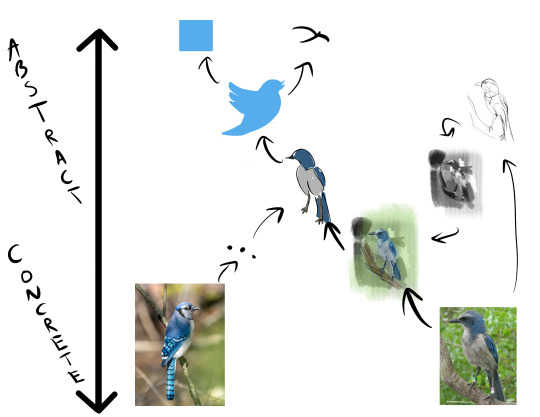
Representation isn't a singular possibility. That is to say that there's no one "true way" to represent a given bird, or in this case the Florida Scrub Jay. There are varying levels of concrete and abstract representation, and these serve different purposes.
Heck, even once we get to the level of abstract, there's different ways to abstract.
For instance, by abstracting to color, we get just a single shade of blue, not a random shade of blue but rather a specific shade that's derived from more concrete representations of blue birds.
But instead of abstracting to color, we can abstract to lines instead, and get a few vague lines that hint at the form of a bird flapping it's wings.
It's that sort of abstraction-to-lines that's useful in things like animation, where using simple linework to emphasize seemingly abstract concepts like "rhythm" and "movement" in a more tangible way can help make the figures feel more alive:

(Image taken from the Barnes & Noble listing of the book Gesture Drawing: Dynamic Movement and Form, by Michael Hampton.)
This is why I've grown to appreciate abstract art, even if it's not the primary thing I draw or my #1 form of consumed art. Because ultimately, abstract art can (though doesn't necessarily have to) serve a purpose: to explore the underlying visual themes throughout countless forms of art.
Explorations of line, color, value, shape, form, etc. have their merit in allowing us to contemplate these ideas in simple abstracted ways that do away with the messy distracting details. And once you get a better understanding of these fundamental art concepts in a more abstract sense, you can use that abstract understanding to reinforce your more concrete representational works. Shapes in underlying compositions, gesture lines in figure drawing, and so on.
Going back to the concrete-abstraction bird chart, you'll notice a little detour on the right-hand side of that chart. That's because I didn't draw my study directly from the photo; instead, I took multiple steps to get there:
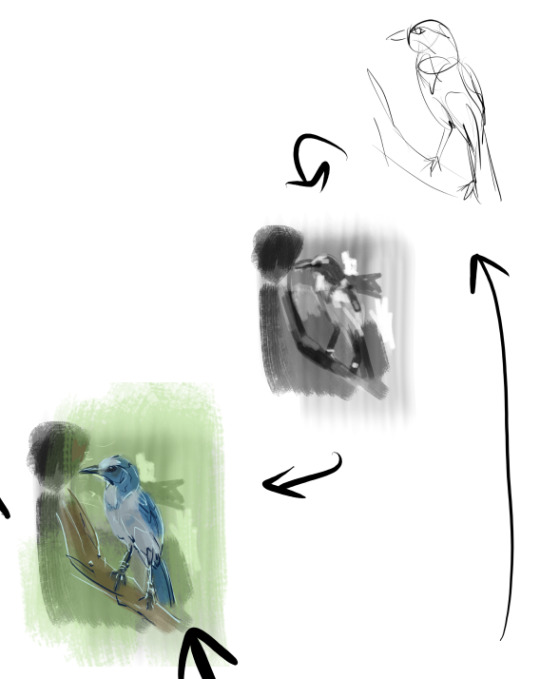
A quickly and roughly-traced line sketch, then a value sketch (setting aside the photo instead of drawing over it at this point), and then adding the colors by eye, along with a few crisp lines to help indicate important edges.
THIS is the whole point of this rambling essay.
This is the crux of the matter.
This notion of concrete vs. abstract is one of the most important tools I have as an artist, because it allows me to divide the process of creating art into various stages with different intentions and different tools.
Instead of one continuous process from start to finish, from beginning to end, from concept to realized image... it's a messy back-and-forth between different processes that jump between simplification and complexity, from abstract to concrete.
It's that back-and-forth and decision-making which makes each and every artwork unique, and which helps add a tremendous amount of meaning.
And naturally, this applies to writing as well.
I don't want to drag this on any longer than it already has, so I'll wrap things up by going back to the very original post. To quote:
"I can instantly tell when someone in one of my STEM classes didn’t pay attention in English class in high school because they can’t read scientific articles without feeding them through ChatGPT."
Yeah. This is EXACTLY why I despise ChatGPT and almost every other form of "generative AI".
Even setting aside the environmental aspects,
Even setting aside the blatant stock manipulation and technocratic bullshit,
Even setting aside the plagiarism...
...ultimately, these statistical models cannot truly replicate the human process of creation.
They simply aggregate values associated with keywords, associations which are algorithmically trained via a dataset, and then spit out some randomized combination of these values. Regardless of whether these values are words or pixels or sound waves.
Letting these generative models do your "thinking" for you?? that can only be utterly devastating to one's own critical thinking skills. I'm quite frankly terrified by how desperately these companies push these "tools" because literally nobody on this godforsaken planet truly benefits from these things excepts shareholders.
Note, this isn't a dig at all forms of machine learning; there's an AMAZING wealth of possibility from machine learning as a whole.
This "AI" stuff just ain't it.
And this is why, ultimately, it's so important to study both humanities and STEM to some degree. These are different fields of knowledge that often have similar underlying skills involved, and learning about these different fields and identiying these common skills will strengthen your ability to use these skills in all sorts of scenarios.
To use an analogy with exercise, swimming and running are two very different forms of exercise. Just because a person is good at athletic running doesn't mean they're good at athletic swimming, and vice-versa.
However, both running and swimming require muscle movements, and the action of muscles requires energy. These muscles consume energy we get from nutrients, but importantly, they need *oxygen* to facilitate this process. And we get oxygen by breathing, right?
So folks learning to do exercise often need to learn to breathe well, too. We breathe almost effortlessly in daily life, but breathing purposefully helps you maximize your oxygen intake and CO2 outtake, making sure your body has enough oxygen to keep its muscles running optimally and for longer. Taking deeper and longer breaths while swimming, for example, can help you dive deeper for longer.
But guess what? Exercise ain't the only thing that needs good breathing. It turns out, when playing woodwind instruments like flutes, where you blow air out into or past the instrument to make sound... breathing is a handy thing as well.
So, all else being equal, a good swimmer will probably be better at breathing when they start athletic running than someone else who is also just starting to practice athletic running.
And, all else being equal, a good swimmer will probably have a better lung capacity and thus be better-equipped to play long passages when they begin learning to play the flute, compared to a different novice flautist who hasn't done any sort of exercises to practice their breathing technique.
Ultimately, there are still differences between breathing for swimming, and breathing for running, and breathing for playing music. But they're ALL still forms of breathing.
Likewise, the various critical thinking skills you learn in various STEM and humanities fields are all different and unique in their applications, but still have fundamental similarities.
Nobody needs to master everything, but to overly neglect STEM or humanities in favor of the other? That's going to hold you back, and make you vulnerable to being unable to handle various types of problems in life.
A lack of science knowledge might make you susceptible to misinformation about science, a lack of historical knowledge makes you susceptible to misinformation about history.
A lack of basic math skill makes it more difficult for you to handle logic problems in real life, and a lack of basic artistic ideas makes it more difficult to derive greater meaning and enjoyment from the plethora of arts in our daily lives; and so on and so forth.
The thing is that I think many people already have a greater deal of "basic knowledge" in various fields than they give themselves credit for. Even —or perhaps especially— when they're young!
Unfortunately, however, education systems (at least where I live, in the good 'ole US of A (derogatory) ) often separate these fields, and struggle to put them in the context of each other. To make it worse, once they're separated they're often further diluted to the point of near uselessness. History becomes rote memorization, art becomes algorithmic, math becomes overly formulaic, and so on.
If they can't be engaged with the educational material, they'll try and disengage. Especially if there are external circumstances such as bullying, chaotic or harmful domestic environments, malnutrition, etc.
And when time limits and testing standards are enforced atop all of this, naturally people turn to whatever "tools" they can to try and take back some of their time for their own interests.
Once upon a time these students would do things like write down the formulas for a test on the inside of their socks, or something. Now, of course... we've got ChatGPT.
There's so, so much to be said on the woes of education, but long story short, we're reaping the unfortunate harvest of decades of neglected education systems.
It's a damn shame, ain't it?
I cannot stress the importance of paying attention in language classes in high school. Maybe the reason why your English teacher taught you about unreliable narrators is because a lot of the media around you is written by unreliable narrators posing as reliable. Maybe they gave you assignments on interpreting texts so you could draw your own conclusions about news articles. Some of you clearly thought English classes were useless in high school and now are unable to engage critically with media.
#quite ironic i used such an extensive programming metaphor#given that I FUCKING HATE programming with all my being#i'd rather chew glass than code#anyways#live laugh love doing anything but programming :)#this is why I switched out of STEM- because I ain't codin' all day#uhhh idk how else to tag this so uh here we go#life advice#yeah that's all i got lol
12K notes
·
View notes
Text
Can a Manual Tester Become a Salesforce Developer? Absolutely. Here's How.
Ever found yourself knee-deep in manual testing and wondering, "What if I could build the stuff I'm testing?" Well, good news: you totally can. Transitioning from manual testing to becoming a Salesforce Developer is not just possible—it might be one of the smartest career moves you can make. Especially if you're already exploring tools like Provar, a Salesforce automation tool that bridges the gap between testers and developers.
In this post, we’ll break down how you can shift gears from manual testing to Salesforce development, the skills you'll need, and how tools like Provar can help along the way.
Why Consider the Switch?
Manual testing is a great entry point into the tech world. You've got the analytical mindset, the attention to detail, and the experience working with systems. But let’s be real: it can feel repetitive, and there's often a ceiling in terms of growth.
Salesforce Development, on the other hand, opens the door to:
Higher salaries and better job stability
Creative problem-solving using Apex (Salesforce's programming language)
More influence in the SDLC (Software Development Life Cycle)
Remote-friendly work opportunities
So if you’re already familiar with how Salesforce apps should behave, you're halfway there.
What Do Salesforce Developers Actually Do?
Salesforce Developers create custom functionality on the Salesforce platform using tools like Apex (similar to Java), Visualforce (for UI), and Lightning Components (modern UI framework). They build things like:
Custom apps and workflows
Automated business processes
Integrations with other systems (like Slack, Gmail, etc.)
This means turning business needs into working features—something manual testers are already good at analyzing.
Skills You Already Have (and How They Translate)
If you’re coming from a manual testing background, you already have some golden skills that will make your move into Salesforce development a whole lot easier.
Understanding of Test Cases: You know how to think through different scenarios and outcomes. This will help you write smarter, more accurate logic and validations when you start coding.
System Thinking: As a tester, you’re already used to seeing the bigger picture and how parts of a system interact. This skill is crucial for designing scalable, efficient solutions as a developer.
Bug Reporting: You’ve spent a lot of time identifying and documenting bugs. That attention to detail translates directly into writing cleaner, error-free code.
Familiarity with Salesforce UI: If you've tested Salesforce apps before, you already have a head start! Knowing your way around the Salesforce interface gives you a solid foundation for building apps, especially when working with Lightning components.
Skills You Need to Pick Up
Don’t worry—you don’t need a Computer Science degree to become a Salesforce Developer. Here's what you'll want to learn:
Apex: Salesforce's proprietary Java-like language
SOQL: Salesforce Object Query Language for database operations
Lightning Web Components: For building responsive UIs
Salesforce Admin Skills: Understand objects, fields, workflows, etc.
Pro tip: Use Provar to bridge the knowledge gap. Since Provar automates testing within Salesforce, it helps manual testers learn about object relationships, workflows, and backend logic organically. It’s like learning to swim while already floating.
Suggested Learning Path
Let’s break it down step-by-step:
Get Certified as a Salesforce Administrator
Understand the basics: objects, fields, workflows, validation rules
Tools: Trailhead (Salesforce’s free learning hub)
Start Learning Apex and SOQL
Use Trailhead modules or YouTube tutorials
Play around in a free Salesforce Developer Org
Build Mini Projects
Try creating a custom app or automating a simple process
Document what you build—this is gold for your portfolio
Work with Provar or Similar Tools
Provar helps you understand how automation integrates with development
Try writing tests while experimenting with backend configurations
Contribute to Open Source or Freelance
Try doing small gigs or helping nonprofits
These experiences build confidence fast
Real Talk: Common Roadblocks (and How to Overcome Them)
"I don’t have a coding background."
That’s okay! Apex is beginner-friendly and well-documented. Start slow and build consistently.
"I’m afraid of making the leap."
Think of this as a skill expansion, not a total restart. You can even start by becoming a Salesforce Test Automation Engineer using Provar, and grow from there.
"Will employers take me seriously?"
Absolutely, especially if you have a strong testing background. Add some Trailhead badges and a few project demos, and you're in the game.
Why Provar Can Be Your Secret Weapon?
Provar is not just for testers. It’s also a great way to:
Understand how test automation works under the hood
Get exposure to Salesforce objects, workflows, and APIs
Bridge the tester-to-developer knowledge gap
As someone already familiar with Salesforce Testing, you can use Provar to:
Write functional test scripts and see how they map to backend logic
Experiment with edge cases and error handling (just like developers do)
Collaborate more effectively with dev teams
So yeah, Provar isn’t just a tool—it’s your training ground.
Career Growth Opportunities
Once you transition to Salesforce Development, you can branch out into:
Salesforce Architect
Technical Consultant
Product Manager (with technical chops!)
Lead Developer or Team Lead
And since Salesforce is huge across industries, you'll find opportunities in finance, healthcare, education, and tech.
Final Thoughts: Start Where You Are
Switching from manual testing to Salesforce Development isn’t just a dream—it’s a plan. With the right mindset, consistent learning, and the help of tools like Provar, you're already on your way. Don’t wait to be "ready." Start exploring, tinkering, and learning today.
Remember, your background in Salesforce Testing already gives you a leg up. All that’s left is to write some code, build something cool, and show the world what you can do.
Thinking about where to begin? Fire up Trailhead, launch a dev org, and automate your first test in Provar. You're not just testing anymore—you're building the future of Salesforce.
Ready to make the jump? We at Provar are cheering you on.
#can a manual tester become salesforce developer#salesforce developer#salesforce testing#provar#salesforce blog
0 notes
Text
Web Services Development

In today’s connected world, web services act as the backbone of communication between applications. Whether you're building mobile apps, web platforms, or enterprise systems, understanding how to develop robust web services is essential for modern developers.
What are Web Services?
A web service is a software component that enables applications to communicate with each other over the internet using standardized protocols like HTTP, XML, or JSON. Web services allow interoperability between different software applications running on various platforms.
Types of Web Services
RESTful Web Services: Use HTTP methods (GET, POST, PUT, DELETE) and are based on REST architecture. Lightweight and widely used.
SOAP Web Services: Use XML-based messaging and offer more rigid structure and security, often used in enterprise systems.
GraphQL: A newer alternative that allows clients to request exactly the data they need.
Common Tools and Frameworks
Node.js (Express): Great for building lightweight REST APIs.
Spring Boot (Java): A robust framework for REST and SOAP services.
Django (Python): Offers built-in support for creating APIs via Django REST Framework.
ASP.NET (C#): Common in enterprise-level SOAP/REST applications.
Sample REST API in Node.js
const express = require('express'); const app = express(); app.get('/api/hello', (req, res) => { res.json({ message: 'Hello from the web service!' }); }); app.listen(3000, () => { console.log('Server running on port 3000'); });
Key Concepts to Understand
HTTP Methods and Status Codes
Authentication (API keys, OAuth, JWT)
Data Serialization (JSON, XML)
Cross-Origin Resource Sharing (CORS)
API Documentation (Swagger/OpenAPI)
Best Practices
Design APIs with clear endpoints and meaningful names.
Use proper status codes to indicate success or errors.
Secure your APIs using authentication and rate limiting.
Provide thorough documentation for developers.
Test APIs using tools like Postman or Insomnia.
Use Cases of Web Services
Mobile App Backends
Payment Gateways
Cloud-Based Services
Weather or Location APIs
Social Media Integration
Conclusion
Web services are critical for building scalable and flexible software systems. By mastering web service development, you’ll be able to connect applications, share data, and build feature-rich platforms that serve users across devices and platforms.
0 notes